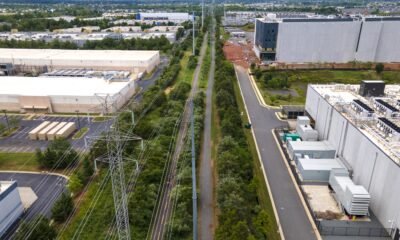Tools & Platforms
Mark Zuckerberg’s hot mic apology to Trump as he ‘wasn’t ready’

Mark Zuckerberg was caught on a hot mic admitting he didn’t quite know how to answer a question about artificial intelligence.
The Meta boss was attending a big, glitzy dinner at the White House on Thursday (4 September), alongside other Silicon Valley leaders such as Tim Cook and Bill Gates.
Donald Trump’s former bestie Elon Musk was seemingly not invited though, as the attendees announced billions in US investments.
The dinner marked Silicon Valley’s strategic realignment with the president’s administration on AI and tech policies.
And Zuckerberg was asked by Trump how much he would be spending ‘over the next few years’. Having paused before his answer, the Facebook co-founder later leaned over to the president to say he ‘wasn’t ready’ as Trump laughed away.
Zuckerberg said he ‘wasn’t ready’. (Will Oliver/EPA/Bloomberg via Getty Images)
Mic’d up and answering the question, Zuckerberg had said: “Oh gosh, um, I think it’s probably going to be something like…I don’t know, $600 billion through [20]28, in the US, yeah…”
Trump laughed: “It’s a lot.”
“No, it’s er, it’s significant,” the seemingly caught-off guard Zuckerberg responded.
But later on during the event, as others around the table chatted away, Zuckerberg could be heard leaning over to say to the president: “Sorry, I wasn’t ready to do our… [inaudible].”
And Trump brought in first lady Melania as he said: “He said ‘I wasn’t ready…’ [inaudible].”
Zuckerberg can then be heard quietly adding: “I wasn’t sure what number you wanted to go with.”
As users shared clips of this moment on social media, the tech giant took to Threads to clarify his comments caught on the hot mic.
“If AI progress keeps accelerating, it’s quite possible we’ll invest even more than this. I had briefed the President that we’re planning to invest $600B+ in the US through ’28 and a significantly higher number through the end of the decade,” Zuckerberg wrote.
“I wasn’t sure which number he was asking about, so I just shared the lower number through ’28 and clarified with him afterwards.”
His relationship with Trump certainly seems to have changed, with the president only a year or so ago threatening him with spending ‘the rest of his life in prison’.
Meta had even banned Trump from its platforms following the 6 January riots in 2021, and the Republican leader referred to Facebook as ‘an enemy of the people’.
But now, they’re sat side-by-side at dinner in the White House with Zuckerberg having donated $1 million to his inauguration.
Tools & Platforms
How Mastercard’s (MA) AI-Powered Payments Push and Tech Partnerships Have Changed Its Investment Story

-
In the past week, Mastercard announced a suite of AI-powered payment products and developer tools, expanded consulting services, and new collaborations with global technology leaders such as Stripe, Google, and Ant International, supporting a rollout of its Agent Pay program to all U.S. cardholders by the end of the holiday season.
-
This initiative positions Mastercard at the forefront of advancing secure, intelligent commerce by making AI-enabled payments and agentic capabilities accessible and scalable for digital merchants and platforms worldwide.
-
We’ll now examine how Mastercard’s push into AI-powered payments and its collaborations with technology partners could reshape its investment narrative.
These 10 companies survived and thrived after COVID and have the right ingredients to survive Trump’s tariffs. Discover why before your portfolio feels the trade war pinch.
If you’re a Mastercard shareholder, you likely believe in the ongoing digital shift in payments, the company’s powerful network effects, and its ability to grow by expanding into new revenue streams like AI-powered services. The recent launch of AI tools and expanded partnerships has the potential to support growth drivers, especially deeper collaboration with tech partners for value-added services, but the most important short-term catalyst remains increasing digital and e-commerce transaction volume. For now, these AI announcements don’t fundamentally alter the biggest risk: faster adoption of alternative payment rails in key emerging markets.
Among the recent announcements, the release of Mastercard’s On-Demand Decisioning (ODD) stands out. This solution offers financial institutions more direct control and flexibility over transaction approvals, supporting the broader catalyst of helping partners automate, personalize and scale digital payments. As Mastercard continues to expand its value-added services beyond core payments, such tools could help reinforce its differentiated service offering.
However, investors should be aware that while Mastercard accelerates innovation, an even faster shift by consumers and merchants to alternative payment options could…
Read the full narrative on Mastercard (it’s free!)
Mastercard’s outlook anticipates $42.6 billion in revenue and $19.9 billion in earnings by 2028. This requires a 12.1% annual revenue growth rate and a $6.3 billion increase in earnings from the current $13.6 billion.
Uncover how Mastercard’s forecasts yield a $644.55 fair value, a 11% upside to its current price.
Tools & Platforms
Efficiency, Ethics, and 2025 Outlook

In the rapidly evolving world of artificial intelligence, a subtle transformation is underway, one that promises to redefine how we interact with technology. AI agents, autonomous software entities capable of performing tasks independently, are quietly infiltrating everyday digital routines, from managing emails to optimizing workflows. Unlike the flashy chatbots of yesteryear, these agents operate in the background, learning from user behavior and executing complex sequences without constant human oversight. This shift, as detailed in a recent HackerNoon article, highlights how companies like OpenAI and Anthropic are pioneering systems that don’t just respond to queries but anticipate needs, turning passive tools into proactive companions.
The appeal lies in their efficiency. Imagine an AI agent that scans your calendar, books flights based on past preferences, and even negotiates better rates—all while you’re asleep. This isn’t science fiction; it’s the reality emerging from advancements in machine learning and natural language processing. Industry insiders note that these agents are built on large language models enhanced with decision-making algorithms, allowing them to handle multi-step processes. For instance, Google’s Project Astra, powered by Gemini 2.0, integrates multimodal inputs like text and images to assist in real-world tasks, such as identifying books on a shelf and recommending the best one, according to a Zilliz blog post.
Autonomy Meets Everyday Utility: How AI Agents Are Scaling Up in 2025
As we move deeper into 2025, expectations for these agents are tempered with realism. IBM’s insights suggest that while hype surrounds “agentic AI,” practical implementations will focus on niche applications rather than universal overhauls. In workplaces, agents are automating repetitive tasks, freeing humans for creative endeavors. Microsoft’s trends report predicts AI agents will simplify life at home and on the job, driven by improved reasoning and memory capabilities. “AI is already making the impossible feel possible,” notes Chris Young, executive vice president at Microsoft, emphasizing the shift from experimentation to adoption.
Yet, challenges persist. Ethical concerns, including data privacy and decision biases, loom large. A Medium piece from Lightcap AI warns that while open-source models democratize access, they also raise risks of misuse. In marketing, MarTech predicts agents will deliver personalized insights, analyzing consumer data to refine campaigns autonomously. This evolution is echoed in fintech, where AI-driven banks like Malaysia’s Ryt Bank use agents for real-time financial decisions, as reported in AI News updates.
From Hype to Integration: Real-World Impacts and Future Trajectories
The integration of AI agents into digital life is accelerating, with posts on X highlighting their potential to dominate sectors like DeFi and content creation by year’s end. Users speculate that agents could manage on-chain trades or even generate indistinguishable social media content, pointing to a future where digital interactions blur with human ones. However, experts caution against overreliance; a WebProNews article on 2025 tech trends underscores the need for ethical frameworks amid agentic AI’s rise, including risks in autonomous warfare and digital deception.
In healthcare, agents are analyzing patient data to aid diagnoses, while in customer service, Vertu’s trends report details hyper-personalized phone interactions via AI. Alibaba’s new GUI automation tools, as covered in AI Agent Store news, enable agents to navigate interfaces seamlessly, transforming user experiences. This quiet revolution, far from the bombast of early AI announcements, is reshaping productivity. As Bindu Reddy’s X post asserts, organizations may deploy hundreds of agents for tasks like workflow automation, fundamentally altering enterprise operations.
Navigating Risks and Opportunities: The Balanced Path Forward
Despite the promise, not all developments are seamless. Anthropic’s Chrome extension for Claude allows browser manipulation, raising security questions, per Crescendo AI news. Dotcominfoway’s blog explores opportunities in business, citing stats like potential $100 million savings from agent-driven efficiencies in supply chains. For insiders, the key is balancing innovation with oversight—ensuring agents enhance, rather than disrupt, human agency.
Looking ahead, Gartner’s designation of agentic AI as a top 2025 trend, as noted in various analyses, signals broader adoption. From autonomous agents in cybersecurity to personalized financial advisors, the trajectory is clear: AI agents are embedding themselves into the fabric of digital existence, promising a more efficient, if more automated, future. As discussions on platforms like Medium and X evolve, the consensus is that 2025 will mark the year these silent operators truly come of age, redefining what it means to live digitally.
Tools & Platforms
Arm Holdings Invests £100M in Bristol AI Chip Design Center, Creating 100 Jobs

In a move that underscores the United Kingdom’s ambitions to solidify its position as a global hub for semiconductor innovation, Cambridge-based Arm Holdings has announced plans to establish a new chip design center in Bristol. This development, reported by the BBC, involves an investment of up to £100 million over the next five years and aims to create around 100 high-skilled jobs in the region. Arm, renowned for its energy-efficient processor designs that power billions of devices worldwide, is targeting advancements in artificial intelligence, automotive technologies, and data centers with this expansion.
The Bristol site will focus on developing next-generation central processing units (CPUs) and graphics processing units (GPUs), building on Arm’s existing ecosystem that includes partnerships with tech giants like Apple, Qualcomm, and Samsung. This initiative comes at a time when the global chip industry is grappling with supply chain disruptions and geopolitical tensions, particularly around U.S.-China trade relations. By expanding domestically, Arm is not only diversifying its operations but also tapping into the UK’s growing pool of engineering talent, much of which has been nurtured by universities in the southwest of England.
Strategic Growth Amid Global Challenges As the UK government pushes forward with its Modern Industrial Strategy, initiatives like Arm’s Bristol center align closely with national goals to boost the digital economy to £1 trillion by the end of the decade. Recent reports from GOV.UK highlight the sector’s potential, emphasizing investments in AI, quantum computing, and cybersecurity to drive economic growth. Industry insiders note that this move by Arm could catalyze further investments in the region, potentially transforming Bristol into a semiconductor hotspot akin to Cambridge’s Silicon Fen.
However, challenges persist. Talent shortages remain a critical hurdle, with the UK facing competition from Silicon Valley and emerging Asian tech hubs. Posts on X, formerly Twitter, from users like those at McKinsey & Company, discuss how frontier technologies such as agentic AI are redefining business, yet underscore the need for skilled workers in design and electronic design automation (EDA). Arm’s expansion addresses this by partnering with local institutions to train engineers, but broader systemic issues, including visa restrictions for international talent, could impede progress.
Innovation at the Edge of Computing Looking ahead to 2025, trends identified in McKinsey’s technology trends outlook point to the integration of AI with edge computing as a pivotal shift. Arm’s designs are particularly suited for this, enabling real-time decision-making in devices from autonomous vehicles to smart factories. X posts from tech analysts highlight how combinations of AI, IoT, and 5G are expanding strategic applications, with companies like Tesla and Amazon leading the charge in innovation management.
The UK’s digital sector already contributes over £150 billion annually to the economy, according to Statista, employing 1.7 million people. Arm’s Bristol venture could amplify this by fostering collaborations in emerging fields like bio-based materials and decentralized renewable energy, as speculated in forward-looking X discussions about post-2025 sectors. Yet, geopolitical frictions and supply chain fragility, as noted in recent UKHotViews analyses, pose risks, with export controls potentially affecting chip production.
Policy Support and Future Prospects The Labour government’s tech policy for 2025, detailed in Taylor Wessing’s insights, emphasizes regulatory frameworks to support digital growth while addressing ethical concerns in AI. Arm’s expansion benefits from such policies, including grants for R&D in critical technologies. Industry observers on X, such as those from Smart Sync Investment Advisory Services, warn of rising tech complexity and cost pressures, yet view semiconductors as the “new oil” powering everything from quantum computing to electric vehicles.
To mitigate these, Arm is investing in domestic silicon ramps, with reports indicating shipments of advanced chips like Huawei’s Ascend series influencing global markets. This positions the UK to compete in the intensifying global tech race, as outlined in Digital Watch Observatory. For industry insiders, the key takeaway is clear: strategic expansions like this not only bolster economic resilience but also pave the way for breakthroughs in AI-driven diagnostics and telemedicine, ensuring the UK’s tech sector remains at the forefront of innovation.
Economic Ripple Effects and Long-Term Vision Beyond immediate job creation, Arm’s Bristol center is expected to stimulate local economies through supplier networks and startup incubators. Data from Financial Times archives show how tech growth has spread beyond the southeast, with “tech towns” like Burnley benefiting from similar booms. Current sentiment on X, including posts from Icetea Software, emphasizes AI’s role in reducing latency through edge computing, which could enhance sectors like agri-tech and mental health apps.
Ultimately, as the UK navigates post-Brexit realities, investments in homegrown tech talent and infrastructure will be crucial. With McKinsey projecting 13 tech trends shaping 2025, including multilingual generative AI, Arm’s move exemplifies proactive adaptation. By leveraging its strengths in efficient chip design, the company—and the nation—stands poised to thrive in an era where digital innovation drives sustainable growth and societal benefits.
-

 Business2 weeks ago
Business2 weeks agoThe Guardian view on Trump and the Fed: independence is no substitute for accountability | Editorial
-
Tools & Platforms1 month ago
Building Trust in Military AI Starts with Opening the Black Box – War on the Rocks
-

 Ethics & Policy2 months ago
Ethics & Policy2 months agoSDAIA Supports Saudi Arabia’s Leadership in Shaping Global AI Ethics, Policy, and Research – وكالة الأنباء السعودية
-

 Events & Conferences4 months ago
Events & Conferences4 months agoJourney to 1000 models: Scaling Instagram’s recommendation system
-

 Jobs & Careers2 months ago
Jobs & Careers2 months agoMumbai-based Perplexity Alternative Has 60k+ Users Without Funding
-

 Podcasts & Talks2 months ago
Podcasts & Talks2 months agoHappy 4th of July! 🎆 Made with Veo 3 in Gemini
-

 Education2 months ago
Education2 months agoMacron says UK and France have duty to tackle illegal migration ‘with humanity, solidarity and firmness’ – UK politics live | Politics
-

 Education2 months ago
Education2 months agoVEX Robotics launches AI-powered classroom robotics system
-

 Podcasts & Talks2 months ago
Podcasts & Talks2 months agoOpenAI 🤝 @teamganassi
-

 Funding & Business2 months ago
Funding & Business2 months agoKayak and Expedia race to build AI travel agents that turn social posts into itineraries





















